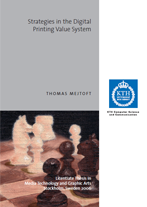Thesis for the degree of Licentiate of Technology to be presented with
due permission for public examination and criticism in Room E2,
Lindstedtsv�gen 3 at the Royal Institute of Technology, KTH,
on 17 November 2006, at 11:00.
Opponent: Prof. Richard Wahlund, Stockholm School of Economics
TRITA-CSC-A 2006:18
ISSN 1653-5723
ISRN KTH/CSC/A--06/18--SE
ISBN 91-7178-475-6
-
The research objective of this thesis is to identify corporate strategies and strategic decisions in the digital printing business and to analyze how these have evolved due to the introduction of digital printing. This thesis comprises three separate studies, all based on qualitative case methodology. The first study is focused on digital printing houses and how their business strategies have changed due to their investment in digital printing production equipment. The second study concentrates on customers in the digital printing value system and how they experience the value they get from purchasing digitally printed products. In the third study, it is analyzed how a successful producer–customer relationship can create value for both parts in a dynamic and changing business environment.
The results indicate that vertical integration among digital printing houses is a valid strategy for overcoming problems related to digital printing, such as not being able to acquire orders suitable for digital printing. The main reason among customers to start using digital printing is the option of ordering short print runs which reduces stock keeping and discarded volumes. This application is the customers’ most important perceived value. The use of more complex applications, such as variable data printing, is very modest, although many respondents say that they either want to start using customization in their print production or already have received some value from simpler variable data printing applications (e.g. addressing or changing logos and names).
The competitive environment in the printing industry is becoming increasingly dynamic and the printing industry is today influenced by a heterogeneous group of competitors and it is therefore important, for printing houses, to engage in hypercompetitive-like behavior. Working with speed, surprise, superior customer satisfaction and continually trying to shift the rules of the industry in the company’s favor, is a strategy to maintain business viability and competitiveness. As a complement to the cost and quality focus, timing and know-how are becoming even more important in the industry when a company wants to satisfy customer needs.
The conclusion is that digital printing is used effectively and successfully when the main purpose is not to print. By striving towards non-printed solutions, digital printing becomes a natural output method when printed material is needed, since it is possible for the customers to order exactly what they want, when they want it, without any need for stock keeping. Vertical integration has helped digital printing houses acquire appropriate input for their printing presses. Horizontal integration into additional output channels, such as electronic publishing, is a natural development in the industry and provides support for the digital printing business.
-
Keywords:
business strategy, customer value, differentiation, digital printing, hypercompetition, vertical integration







